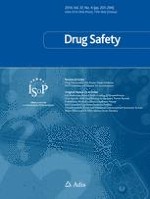Published in:

01-08-2007 | Original Research Article
Incidence of Allergic Reactions Associated with Antibacterial Use in a Large, Managed Care Organisation
Authors:
Catherine B. Johannes, Najat Ziyadeh, Dr John D. Seeger, Ed Tucker, Christoph Reiter, Gerald Faich
Published in:
Drug Safety
|
Issue 8/2007
Login to get access
Abstract
Background: Data on the incidence of serious allergic reactions to fluoroquinolone antibacterials are mainly derived from spontaneous reports that cannot be used to accurately estimate incidence.
Methods: This study estimated the drug-specific incidence of serious allergic reactions after fluoroquinolone, cephalosporin and phenoxymethylpenicillin potassium exposure, using claims for healthcare services with confirmation through medical record abstraction within a large health insurer database. Cohorts exposed to each antibacterial of interest (moxifloxacin, levofloxacin, ciprofloxacin, gatifloxacin, cephalosporins and penicillin) were identified, and followed for 14 days for anaphylaxis (9th revision of the International Classification of Diseases [ICD-9] code 995.0), other allergic drug reactions (ICD-9 995.2, 995.3) or cardiopulmonary resuscitation.
Results: The incidence per 10 000 first dispensings of any allergic diagnosis made in the hospital or emergency department was similar for moxifloxacin (4.3; 95% CI 3.5, 5.3), penicillin (4.7; 95% CI 3.8, 5.7) and ciprofloxacin (5.4; 95% CI 4.4, 6.5). The incidence for moxifloxacin was lower than that for levofloxacin (8.7; 95% CI 7.4, 10.0), gatifloxacin (6.7; 95% CI 5.6, 7.9) and the cephalosporins (7.5; 95% CI 6.3, 8.8). The incidence of anaphylaxis/anaphylactoid reactions after first dispensings was similar for the fluoroquinolones: 0.1 (95% CI 0.0, 0.3) for ciprofloxacin, 0.3 (95% CI 0.1, 0.5) for moxifloxacin, 0.3 (95% CI 0.1, 0.6) for gatifloxacin and 0.5 (95% CI 0.3, 0.9) for levofloxacin; and comparable with that of the cephalosporins (0.2; 95% CI 0.0, 0.4) and penicillin (0.1; 95% CI 0.0, 0.3).
Conclusions: Anaphylactic reactions were rare and their incidence did not differ substantially among the drug groups studied. By determining the occurrence of reactions following defined exposures, these results provide a context for the interpretation of spontaneous reports of allergic reactions.